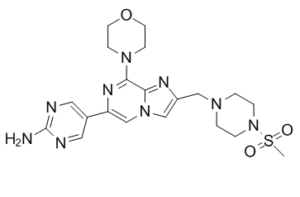ETP-46321
This product is for research use only, not for human use. We do not sell to patients.

For small sizes, please check our retail website as below: www.invivochem.com
| Size | Price | Stock |
|---|---|---|
| 100mg | $1950 | Check With Us |
| 200mg | $2925 | Check With Us |
| 500mg | $4935 | Check With Us |
Cat #: V2910 CAS #: 1252594-99-2 Purity ≥ 98%
Description: ETP-46321 is a novel, potent and orally bioavailable inhibitor of PI3Kα and PI3Kδ with Kiapp values of 2.3 nM and 14.2 nM, respectively in biochemical assays.
Top Publications Citing Invivochem Products
Publications Citing InvivoChem Products
Product Promise

- Physicochemical and Storage Information
- Protocol
- Related Biological Data
- Stock Solution Preparation
- Quality Control Documentation
| Molecular Weight (MW) | 473.55 |
|---|---|
| Molecular Formula | C20H27N9O3S |
| CAS No. | 1252594-99-2 |
| Storage | -20℃ for 3 years in powder formr |
| -80℃ for 2 years in solvent | |
| Solubility In Vitro | DMSO: ≥ 33 mg/mLr |
| Water: <1 mg/mLr | |
| Ethanol: | |
| SMILES Code | NC1=NC=C(C2=CN3C(C(N4CCOCC4)=N2)=NC(CN5CCN(S(=O)(C)=O)CC5)=C3)C=N1 |
| Synonyms | ETP46321; ETP-46321; ETP 46321 |
| Protocol | In Vitro | ETP-46321 is selected to be screened against other PI3K isoforms. ETP-46321 is more potent against isoform α (Kiapp=2.3 nM). ETP-4632, has been profiled and shown to be a potent PI3K α and δ inhibitor, highly selective versus mTOR and 288 representative kinases. ETP-46321 is also tested against three of the p110α mutant enzymes detected in human cancers (E542K, E545K and H1047R), being equipotent against these mutants when compared to the wild type protein (Kiapp=2.33, 1.77 and 1.89 nM for PI3Kα-H1047R, PI3Kα-E545K and PI3Kα-E542K, respectively). ETP-46321 inhibits the phosphorilation of AKT in U2OS cell line with an IC50 of 8.3 nM. |
|---|---|---|
| In Vivo | ETP-46321, is selected for in vivo studies based on its appealing pharmacokinetic profile in BALB-C mice, low in vivo Clearance (0.6 L/h/Kg) and good oral bioavailability (90%). ETP-46321 demonstrates a good pharmacokinetic profile in mice and is selected for preliminary in vivo evaluation in a lung tumor mouse model driven by a K-RasG12V oncogenic mutation, showing significant tumor growth inhibition, and reduction of the tumor metabolic activity as measured by positron emission tomography (PET) techniques. |
These protocols are for reference only. InvivoChem does not
independently validate these methods.
| Solvent volume to be added | Mass (the weight of a compound) | |||
|---|---|---|---|---|
| Mother liquor concentration | 1mg | 5mg | 10mg | 20mg |
| 1mM | 2.1117 mL | 10.5585 mL | 21.1171 mL | 42.2342 mL |
| 5mM | 0.4223 mL | 2.1117 mL | 4.2234 mL | 8.4468 mL |
| 10mM | 0.2112 mL | 1.0559 mL | 2.1117 mL | 4.2234 mL |
| 20mM | 0.1056 mL | 0.5279 mL | 1.0559 mL | 2.1117 mL |
The molarity calculator equation
Mass(g) = Concentration(mol/L) × Volume(L) × Molecular Weight(g/mol)
Mass
=
Concentration
×
Volume
×
Molecular Weight*
The dilution calculator equation
Concentration(start)
×
Volume(start)
=
Concentration(final)
×
Volume(final)
This equation is commonly abbreviated as: C1 V1 = C2 V2
Concentration(start)
C1
×
Volume(start)
V1
=
Concentration(final)
C2
×
Volume(final)
V2
Step One: Enter information below
Dosage mg/kg
Average weight of animals g
Dosing volume per animal µL
Number of animals
Step Two: Enter the in vivo formulation
%DMSO
+
%
+
%Tween 80
+
%ddH2O
Calculation Results:
Working concentration:
mg/ml;
Method for preparing DMSO master liquid:
mg
drug pre-dissolved in
µL
DMSO(Master liquid concentration
mg/mL)
,Please contact us first if the concentration exceeds the DMSO solubility of the batch of drug.
Method for preparing in vivo formulation:
Take
µL
DMSO master liquid, next add
µL
PEG300, mix and clarify, next add
µL
Tween 80,mix and clarify, next add
µL
ddH2O,mix and clarify.
Note:
- (1) Please be sure that the solution is clear before the addition of next solvent. Dissolution methods like vortex, ultrasound or warming and heat may be used to aid dissolving.
- (2) Be sure to add the solvent(s) in order.




































